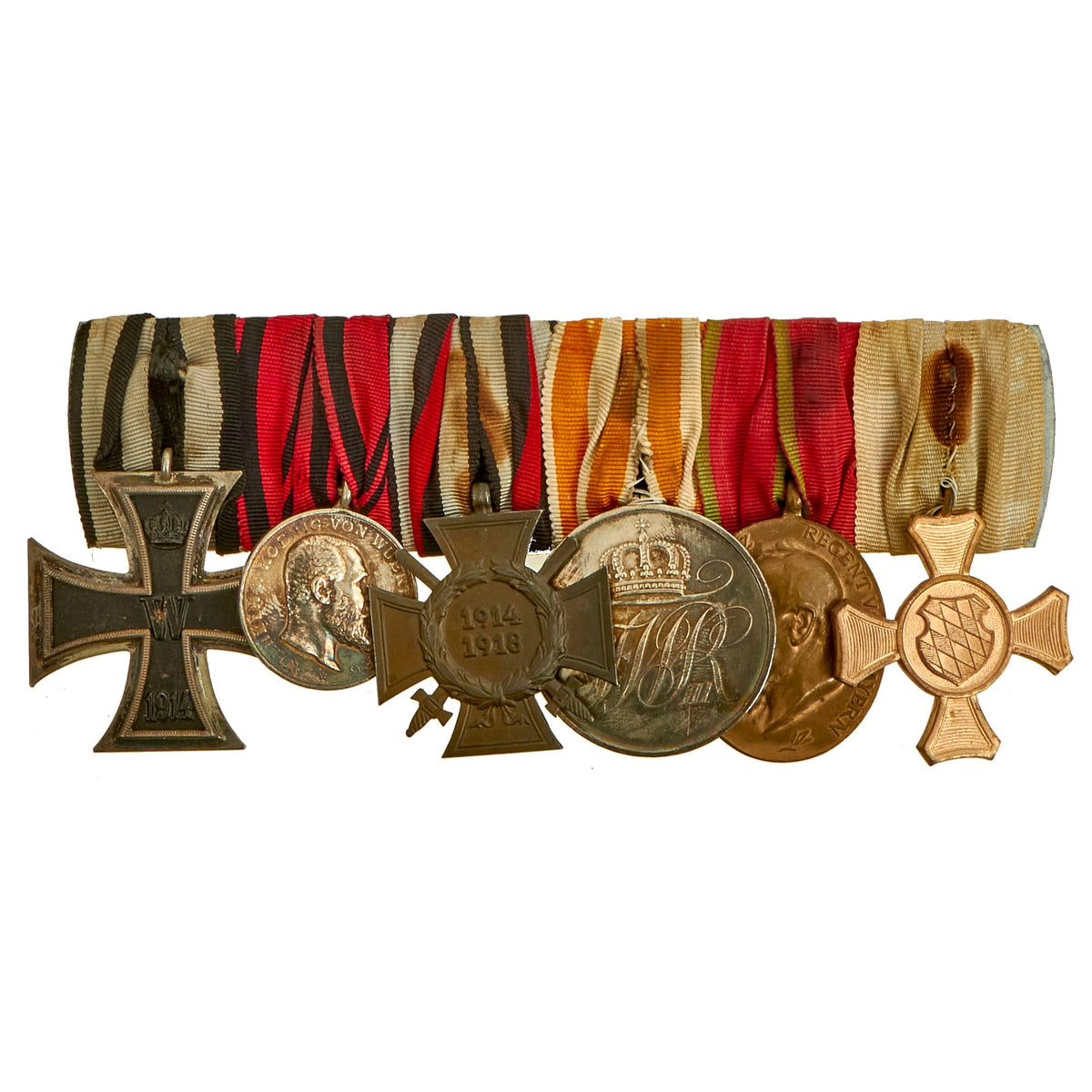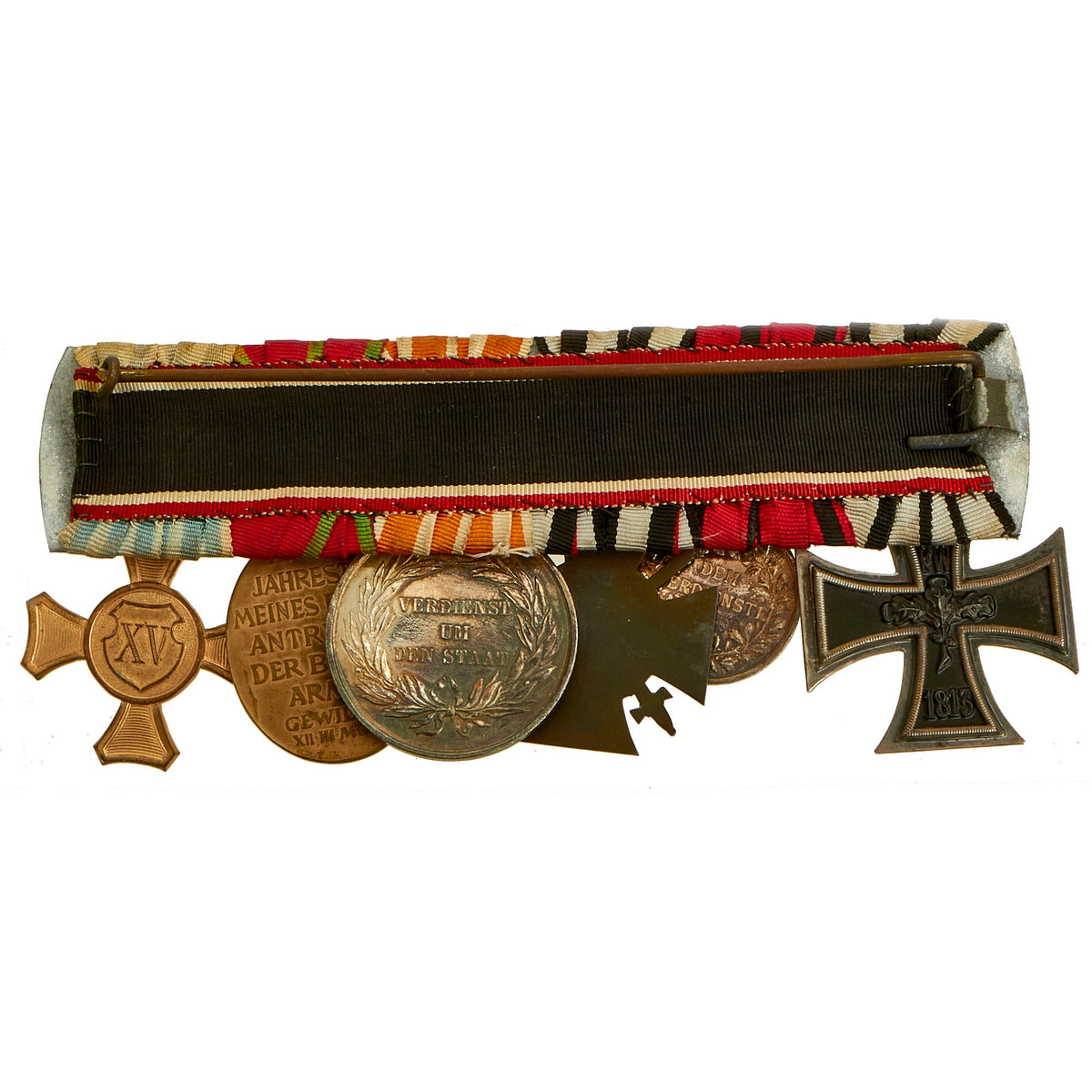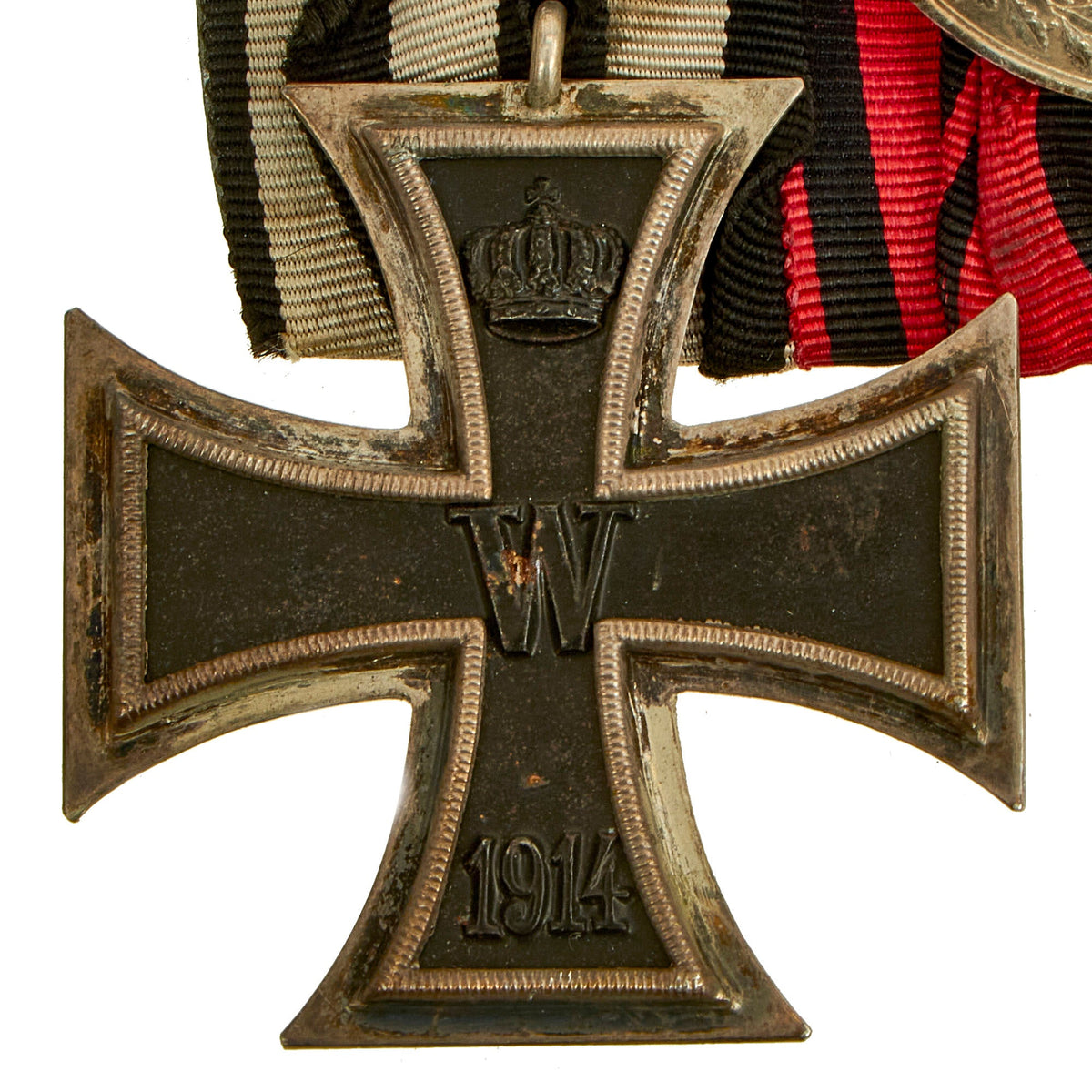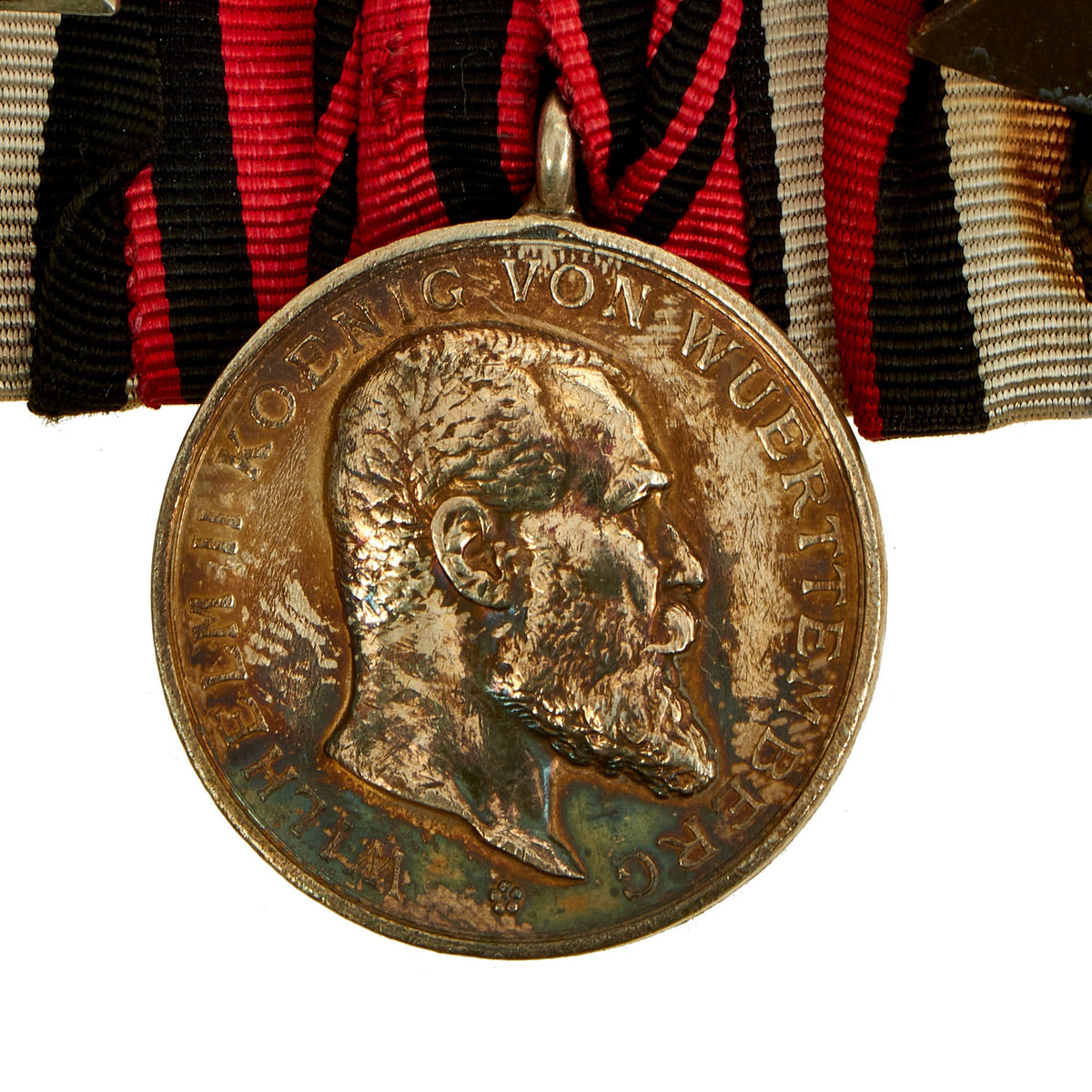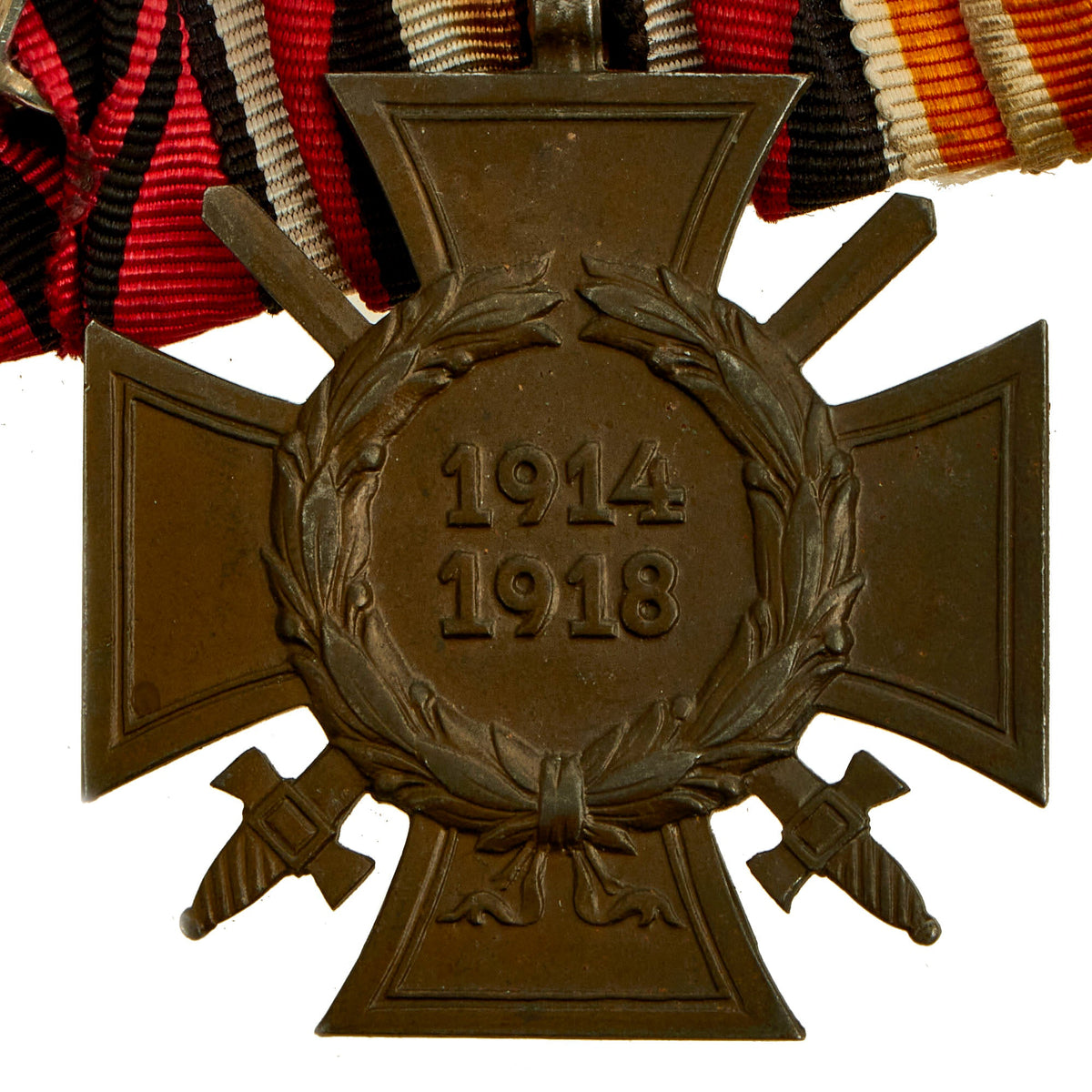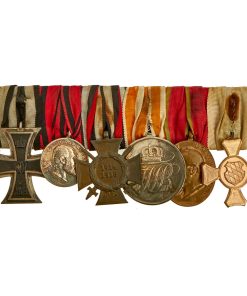Original German WWI Era Medal Bar with 1914 EKII, Hindenburg Cross & Bavarian 1905 Luitpold Medal – 6 Awards Original Items
$ 395,00 $ 118,50
Original Item: One-of-a-kind. This is a fantastic genuine medal set, which we assume was owned by a German soldier who fought during WWI, and possibly served during the interwar years. They may have served during WWII, however there are no medals from that period. They also seem to have a lot of awards from the Kingdom of Bavaria, so they may have been from that area, or at least served there.
The set of 6 medals offered in good condition is mounted on a very nice metal supported medal bar, which has a long brass securing pin. It is backed with a red / white / black ribbon, which looks to be from war service award. The colors are well retained, with some light staining and overall oxidation on the various awards.
It consists of the following medals with Ribbons:
– Imperial German WWI Iron Cross 1914 2nd Class Medal (Eisernes Kreuz 2. Klasse, or EKII).
– Württemberg Wilhelm II Military Merit Medal in Silver with Red/Black Ribbon
– German WWI Honor Cross of the World War 1914/1918 Medal (Hindenburg Cross) with Swords (For Combat). Marked G18 on the back.
– German General Honor Decoration for Civil Merit in Silver – 2nd Class
– Bavarian Prince Regent Luitpold 1905 Jubilee 70 Anniversary Military Medal
– Bavarian Military Long Service Cross First Class – 15 Years of Service.
Below is an explanation of each medal in detail:
German WWI Prussian Iron Cross 2nd Class with Ribbon:
Established by Frederick William in 1813 for gallantry in action, the Eisernes Kreuz (EK) decoration was revived several times for later conflicts. The bulk of the issues are divided into 1st and 2nd class versions, but a rare and superior ‘Grand Cross’ was also awarded for successful field commanders. During WW1 the lower decoration was freely awarded with 5½ million second class types issued. Originally, the Iron Cross was an award of the Kingdom of Prussia, however given Prussia’s pre-eminent place in the German Empire formed in 1871, it became an award for all of Germany.
The basic design of the WW1 crosses is a central Tatzenkreuz (cross pattée) struck from iron and mounted in a silver frame which has a raised crenulated decorative border. The obverse of the cross bears the date 1914 under a crowned ‘W’ monogram. Reverse bears an oak leaf cluster with the date of the decoration’s institution, 1813 underneath – the crowned initials of Frederick William are in the top arm above the oak leaf cluster. Suspension for second-class types is by means of a ring, and frequently this ring bears a maker’s stamp.
Please examine the edge seam for authentication, which is not present on reproductions. Iron crosses were commonly constructed from an iron core sandwiched in a surrounding two part silver frame, normally the seam of these two silver parts is visible around the edge of the cross as is seen on this fine example.
Kingdom of Württemberg Wilhelm II Military Merit Medal in Silver
This is the standard military merit award for the Kingdom of Württemberg during the WWI era, known as the Militärverdienstmedaille in Silber. The individual German Kingdoms, Duchies, and states during WWI all had their own leaders and medals, which varied quite a bit in design. This medal features a front face with the head of King Wilhelm II of Württemberg facing right, circumscribed WILHELM II KOENIG VON WUERTTEMBERG. The rear face has a ring of laurels around the edge, with FÜR TAPFERKEIT UND TREUE (For bravery and loyalty) in the center. The medal was instituted in 1818 to be awarded for military merit. Wilhelm II became king on 6 October 1891 and the new version of the medal bearing his image was introduced on 26 June 1892. It was suppressed in 1918 when, along with all other German rulers, Wilhelm was deposed at the end of World War I
This example is in good shape, with a lot of the silvering remaining, with the usual oxidation. It is mounted on the correct Post-1914 yellow and black ribbon.
Hindenburg Cross with Crossed Swords (for combat):
The Honor Cross of the World War 1914/1918 (German: Das Ehrenkreuz des Weltkriegs 1914/1918), commonly, but incorrectly, known as the Hindenburg Cross was established by Field Marshal Paul von Hindenburg, President of the German Republic, by an order dated 13 July 1934, to commemorate the distinguished deeds of the German people during the First World War. This was Germany’s first official service medal for soldiers of Imperial Germany who had taken part in the war, and where they had since died it was also awarded to their surviving next-of-kin. Shortly after its issuance, the government of NSDAP Germany declared the award as the only official service decoration of the First World War and further forbid the continued wearing of German Free Corps awards on any military or paramilitary uniform of a state or NSDAP Party organization.
The General Honor Decoration (Allgemeines Ehrenzeichen) was a decoration of Prussia. The decoration can trace its origin back to awards established in 1793 by King Frederick William III of Prussia. The various levels of the decoration recognized peacetime merit to Prussia. These awards were often to commemorate long and particularly meritorious service or for special contributions from people who would not be considered for appointment to an order due to their rank. In general, recipients were lower and mid-level officials and officers.
The General Honor Decoration originally consisted of a First Class medal in gold, and a Second Class medal in silver. The obverse of the medallion bore the inscription VERDIENST UM DEN STAAT (Merit for the State) in three lines, while the reverse bore the crowned cypher of Friedrich Wilhelm III, the founder of the award. After 1814, the gold medal was discontinued being replaced by a silver cross for the First Class. In January 1830, the cross was made into the Fourth Class of the Order of the Red Eagle, leaving only the silver medal for award. In 1890, a gold medal was reestablished as a higher level class. In 1900, the gold medal was replaced by the Cross of Honor of the General Honor Decoration, which was awarded along with the Second Class Medal, and a Third Class Medal in bronze established in 1912, until the fall Prussia in 1918.
Bavarian Prince Regent Luitpold Jubilee Medal 1905
dated 12. März 1905, Luitpold, Prinz von Bayern, regent of Bavaria, announced the creation of the Jubilee Medal (Jubiläumsmedaille) for the Bavarian Army. The event was the 70th anniversary of Luitpold’s entering the army. This medal is a bronze medal, oval in form. It is worn on a watered ribbon in the colors of the House and Knighly Order of St. Hubertus (cinnabar red with light green edges/zinnoberrot mit hellgrünen Randstreifen). The obverse has a bust of Luitpold and the inscription “LUITPOLD PRINZ-REGENT VON BAYERN“. The reverse has the inscription: “AM 70. JAHRESTAG MEINES DIENST-ANTRITTES DER BAYER. ARMEE GEWIDMET XII. III. MCMV“
Fast Shipping with Professional Packaging
Thanks to our longstanding association with UPS FedEx DHL, and other major international carriers, we are able to provide a range of shipping options. Our warehouse staff is expertly trained and will wrap your products according to our exact and precise specifications. Prior to shipping, your goods will be thoroughly examined and securely secured. We ship to thousands clients each day across multiple countries. This shows how we're dedicated to be the largest retailer on the internet. Warehouses and distribution centres can be located throughout Europe as well as the USA.
Note: Orders with more than one item will be assigned a processing date depending on the item.
Before shipping before shipping, we'll conduct a thorough inspection of the items you have ordered. Today, the majority of orders will be delivered within 48 hours. The delivery time will be between 3-7 days.
Returns
The stock is dynamic and we cannot completely manage it because multiple stakeholders are involved, including our factory and warehouse. So the actual stock may alter at any time. It's possible that you may not receive your order once the order has been made.
Our policy is valid for a period of 30 days. If you don't receive the product within 30 days, we are not able to issue a refund or an exchange.
You can only return an item if it is unused and in the same state as the day you received it. You must have the item in its original packaging.
Related products
Uncategorized
Uncategorized
Uncategorized
Uncategorized
Armored Burgonet Helmet & Polearm from Scottish Castle Leith Hall Circa 1700 Original Items
Uncategorized
Uncategorized
Uncategorized
Uncategorized
Australian WWII Owen MK1 Machine Carbine SMG Custom Fabricated Replica with Sling Original Items
Uncategorized
Uncategorized
Uncategorized
Uncategorized
Armoured Fighting Vehicles of the World: AFVs of World War One (Hardcover Book) New Made Items
Uncategorized
Uncategorized
Angolan Rebel 1970s era 60mm Inert Display Mortar from Angolan Civil War Original Items
Uncategorized
Uncategorized
Uncategorized
Uncategorized
Uncategorized
Band of Brothers ORIGINAL GERMAN WWII Le. F.H. 18 10.5cm ARTILLERY PIECE Original Items
